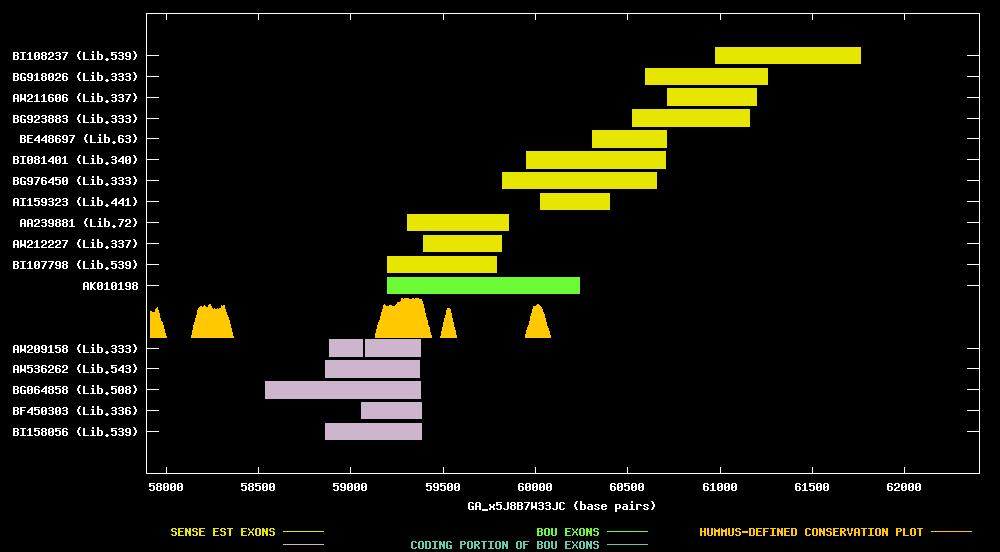




| Candidate UniGene cluster: | UniGene Cluster Mm.183060 |
| Description: | RIKEN cDNA 2310076G09 gene |
| Best-Of-UniGene (BOU) Sequence | AK010198 |
| Genomic Coordiantes Displayed: | Bases 57892 to 62405 of contig GA_x5J8B7W33JC |
| BOU Orientation Along Contig: | RIGHT-TO-LEFT with respect to contig |
| Link to JPEG of genomic mapping | Mm.183060.jpeg |
| Best sense EST/protein match: | No protein match with an e-value of less than 1e-10 |
| Best antisense EST/protein match: | No protein match with an e-value of less than 1e-10 |

ANTISENSE ESTs
| AW209158 | cDNA clone IMAGE:2582243 | infiltrating ductal carcinoma | 3' read |  | ||
| AW536262 | cDNA clone G0102D07 | 3' read |  | |||
| BG064858 | cDNA clone H3024F06 | 3' read |  | |||
| BF450303 | cDNA clone IMAGE:3674487 | spontaneous tumor, metastatic to mammary. stem cell origin. | 3' read |  | ||
| BI158056 | cDNA clone IMAGE:5061305 | tumor, gross tissue | 5' read |  |
| BI107798 | cDNA clone IMAGE:5031460 | tumor, gross tissue | 5' read | |||
| AW212227 | cDNA clone IMAGE:2649211 | tumor, gross tissue | 3' read | |||
| AA239881 | cDNA clone IMAGE:692738 | liver | 5' read | |||
| AI159323 | cDNA clone IMAGE:1447878 | mammary gland | 5' read | |||
| BG976450 | cDNA clone IMAGE:4976608 | infiltrating ductal carcinoma | 5' read | |||
| BI081401 | cDNA clone IMAGE:5010788 | tumor, biopsy sample | 5' read | |||
| BE448697 | cDNA clone IMAGE:3331105 | spleen | 5' read | |||
| BG923883 | cDNA clone IMAGE:4953379 | infiltrating ductal carcinoma | 5' read | |||
| AW211606 | cDNA clone IMAGE:2649211 | tumor, gross tissue | 5' read | |||
| BG918026 | cDNA clone IMAGE:4948049 | infiltrating ductal carcinoma | 5' read | |||
| BI108237 | cDNA clone IMAGE:5031835 | tumor, gross tissue | 5' read |